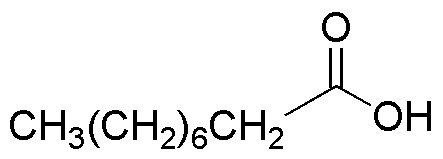Nonanoic acid is widely utilized in research focused on:
- Surfactant Production: This compound is used to create surfactants that improve the wetting and spreading properties of liquids, making it valuable in industries like agriculture for pesticide formulations.
- Flavor and Fragrance Industry: Nonanoic acid serves as a key ingredient in the synthesis of flavors and fragrances, providing a fruity aroma that enhances food products and personal care items.
- Cosmetic Formulations: Its emollient properties make it an excellent choice for skin care products, helping to improve texture and moisture retention in lotions and creams.
- Biodegradable Plastics: Nonanoic acid is explored in the development of biodegradable polymers, offering an eco-friendly alternative to traditional plastics, which is increasingly important in sustainability efforts.
- Pharmaceutical Applications: This compound is also investigated for its potential in drug delivery systems, where it can enhance the solubility and bioavailability of certain medications.
General Information
Properties
Safety and Regulations
Applications
Nonanoic acid is widely utilized in research focused on:
- Surfactant Production: This compound is used to create surfactants that improve the wetting and spreading properties of liquids, making it valuable in industries like agriculture for pesticide formulations.
- Flavor and Fragrance Industry: Nonanoic acid serves as a key ingredient in the synthesis of flavors and fragrances, providing a fruity aroma that enhances food products and personal care items.
- Cosmetic Formulations: Its emollient properties make it an excellent choice for skin care products, helping to improve texture and moisture retention in lotions and creams.
- Biodegradable Plastics: Nonanoic acid is explored in the development of biodegradable polymers, offering an eco-friendly alternative to traditional plastics, which is increasingly important in sustainability efforts.
- Pharmaceutical Applications: This compound is also investigated for its potential in drug delivery systems, where it can enhance the solubility and bioavailability of certain medications.
Documents
Safety Data Sheets (SDS)
The SDS provides comprehensive safety information on handling, storage, and disposal of the product.
Product Specification (PS)
The PS provides a comprehensive breakdown of the product’s properties, including chemical composition, physical state, purity, and storage requirements. It also details acceptable quality ranges and the product's intended applications.
Certificates of Analysis (COA)
Search for Certificates of Analysis (COA) by entering the products Lot Number. Lot and Batch Numbers can be found on a product’s label following the words ‘Lot’ or ‘Batch’.
*Catalog Number
*Lot Number
Certificates Of Origin (COO)
This COO confirms the country where the product was manufactured, and also details the materials and components used in it and whether it is derived from natural, synthetic, or other specific sources. This certificate may be required for customs, trade, and regulatory compliance.
*Catalog Number
*Lot Number
Safety Data Sheets (SDS)
The SDS provides comprehensive safety information on handling, storage, and disposal of the product.
DownloadProduct Specification (PS)
The PS provides a comprehensive breakdown of the product’s properties, including chemical composition, physical state, purity, and storage requirements. It also details acceptable quality ranges and the product's intended applications.
DownloadCertificates of Analysis (COA)
Search for Certificates of Analysis (COA) by entering the products Lot Number. Lot and Batch Numbers can be found on a product’s label following the words ‘Lot’ or ‘Batch’.
*Catalog Number
*Lot Number
Certificates Of Origin (COO)
This COO confirms the country where the product was manufactured, and also details the materials and components used in it and whether it is derived from natural, synthetic, or other specific sources. This certificate may be required for customs, trade, and regulatory compliance.

